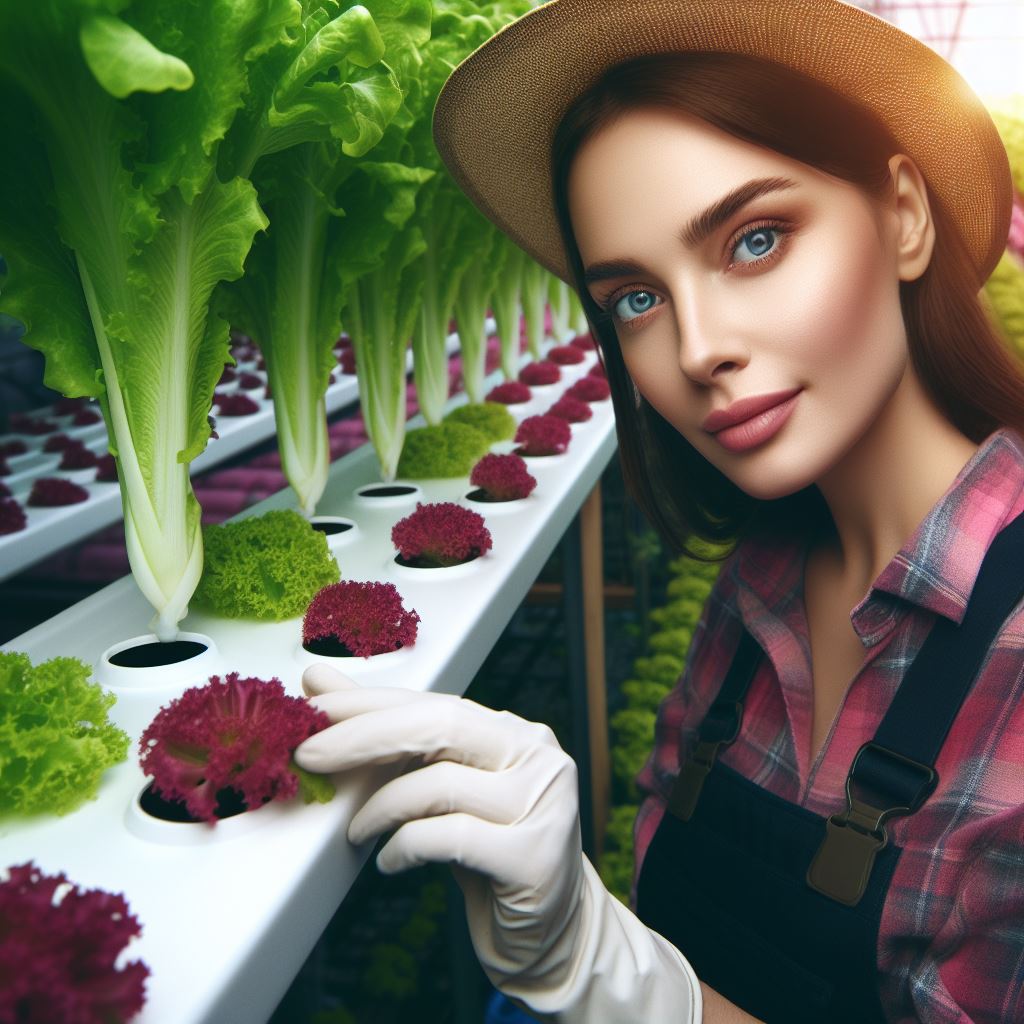Introduction
Importance of maximizing garden space in urban areas
In urban areas, maximizing garden space is crucial due to the limited land available.
Vertical farming offers a solution to this problem by utilizing vertical space.
Explanation of vertical farming
Vertical farming is a method of growing plants in vertically stacked layers, using hydroponic or aeroponic systems.
It allows for the cultivation of crops in indoor environments, such as buildings or greenhouses.
By implementing vertical farming, gardeners can significantly increase their yield and make the most out of limited space.
With traditional gardening methods, there is a limited amount of ground available for planting.
However, in vertical farming, plants are grown in layers, often stacked on top of each other, making it possible to cultivate more plants in a smaller area.
Another advantage of vertical farming is that it eliminates the need for large amounts of soil.
Instead, plants are grown using nutrient-rich solutions or air mist, resulting in less soil erosion and water waste.
This method also reduces the risk of pests and diseases, as plants are grown in controlled environments.
Moreover, vertical farming allows for year-round cultivation, unaffected by external weather conditions.
It enables gardeners to have a continuous production cycle, ensuring a steady supply of fresh produce throughout the year, regardless of seasonal changes.
In review, vertical farming provides an innovative solution to maximize garden space in urban areas.
By utilizing vertical space and adopting efficient cultivation methods, gardeners can significantly increase their crop yield and overcome the limitations imposed by limited land availability.
What is vertical farming?
Definition and concept
Vertical farming is an innovative approach to agriculture that maximizes garden space by utilizing vertical layers.
Transform Your Agribusiness
Unlock your farm's potential with expert advice tailored to your needs. Get actionable steps that drive real results.
Get StartedThis method allows plants to be stacked one on top of another.
The concept of vertical farming revolves around the idea of growing crops in vertically stacked layers, using specialized equipment and technology.
This allows for the efficient use of space and resources.
Vertical farming also relies heavily on automation and control systems.
These systems monitor and adjust factors such as temperature, humidity, and nutrient levels to optimize plant growth.
This level of precision ensures the highest quality produce. The benefits of vertical farming are numerous.
Firstly, it allows for year-round crop production, reducing dependence on seasonal changes.
This, combined with the lack of reliance on soil, makes vertical farming resistant to droughts and other adverse weather conditions.
Vertical farming also reduces the need for large amounts of land. In urban areas where space is limited, vertical farms can be built vertically, taking advantage of unused building structures.
Main principles and techniques
One of the main principles of vertical farming is the use of hydroponics, a technique that involves growing plants in nutrient-rich water without soil.
By eliminating soil, vertical farms can take advantage of a smaller footprint and increase crop yield.
Another important technique used in vertical farming is aeroponics, which involves growing plants in an air or mist environment.
This allows for even greater space efficiency as plants can be suspended in the air, allowing their roots to be sprayed with nutrients.
LED lighting is a crucial component of vertical farming.
By mimicking natural sunlight, LED lights provide the necessary spectrum for plant growth.
This artificial lighting allows vertical farms to operate in indoor environments, regardless of external conditions.
In addition, vertical farming can significantly reduce water usage.
Compared to traditional agriculture, hydroponic systems in vertical farms use up to 95% less water while still producing comparable yields.
This makes vertical farming a sustainable solution for water-scarce regions.
Furthermore, vertical farming eliminates the need for harmful pesticides and herbicides.
With the controlled environment, pests can be minimized naturally, reducing the need for chemical interventions.
This results in safer and healthier produce for consumers.
Vertical farming also provides opportunities for localized food production.
By establishing vertical farms in urban areas, fresh produce can be grown and harvested closer to the point of consumption, reducing the environmental impact of transportation and ensuring freshness.
Showcase Your Farming Business
Publish your professional farming services profile on our blog for a one-time fee of $200 and reach a dedicated audience of farmers and agribusiness owners.
Publish Your ProfileAll in all, vertical farming is a revolutionary approach to agriculture that maximizes garden space by utilizing vertical layers.
By employing techniques such as hydroponics, aeroponics, and LED lighting, vertical farms can efficiently produce high-quality, sustainable, and locally sourced produce.
The benefits of vertical farming, including year-round production, reduced land and water usage, and elimination of harmful chemicals, make it a promising solution for the future of food production.
Read: Raised Bed Gardening: Pros and Cons
Benefits of vertical farming
Maximizing garden space
- Vertical farming increases soil usage efficiency by utilizing vertical structures such as walls and shelves.
- By growing plants vertically, more crops can be produced in a smaller area.
Year-round crop production
- Vertical farming eliminates seasonal limitations, allowing for continuous crop cultivation throughout the year.
- With a controlled environment, optimal growth conditions can be maintained, resulting in higher yield.
Resource efficiency
- Vertical farming reduces water usage by implementing recirculation systems that conserve and reuse water.
- Energy consumption is minimized through the use of energy-efficient LED lights for plant growth.
Types of vertical farming systems
Vertical farming systems offer numerous advantages, allowing individuals to maximize their garden space effectively.
Tower Systems
Tower systems utilize vertical garden towers and aeroponic towers, providing multiple levels for plants to grow.
This structure maximizes space utilization, making it ideal for urban areas where horizontal space is limited.
Additionally, tower systems also allow for efficient water usage as the plants receive nutrients through mist, eliminating the need for excessive watering.
Furthermore, these systems eliminate the use of soil, reducing the risk of soil-borne diseases and making maintenance easier.
- Vertical garden towers: tall structures with multiple levels for growing plants vertically.
- Aeroponic towers: using mist to deliver nutrients directly to plant roots
Benefits: maximize space, efficient water usage, eliminates the need for soil, easy to maintain.
Wall-mounted Systems
Another type of vertical farming system is the wall-mounted system.
Vertical wall gardens and pocket gardens are structures that allow plants to grow vertically on walls or small pockets filled with soil.
These systems are particularly suitable for small spaces and urban settings where horizontal space is scarce. They also enhance the aesthetics of buildings, adding greenery and beauty to otherwise dull walls.
- Vertical wall gardens: plants are grown on a vertical structure attached to a wall.
- Pocket gardens: small pockets filled with soil to grow plants vertically.
Explanation: These systems are ideal for small spaces, urban areas, and can add aesthetic value to buildings.
Greenhouse Systems
Greenhouse systems are also popular in vertical farming.
With stacked layers of crops, farms can utilize vertical space effectively while maintaining a controlled environment.
The controlled environment in a greenhouse protects crops from extreme weather conditions such as frost, excessive heat, and heavy rain.
This extended growing season allows for year-round production of crops, ensuring a consistent food supply regardless of the external climate.
Greenhouse systems also offer the advantage of increased production.
With multiple layers of crops, farmers can yield a higher harvest compared to traditional farming methods.
Additionally, greenhouse farming is known for its efficient resource usage.
Water conservation is a significant benefit, as hydroponic and aquaponic systems utilize nutrient-rich water to nourish crops without the need for excessive irrigation.
Moreover, greenhouse farming reduces the need for pesticides, creating a more sustainable and environmentally friendly approach.
It also has lower energy consumption compared to conventional farming methods.
- Stacked layers of crops: multiple levels of plant beds within a controlled environment.
- Hydroponic and aquaponic systems: growing plants using nutrient-rich water (hydroponics) or fish waste (aquaponics).
Benefits of Greenhouse Farming
- Extended growing season: allows for year-round production of crops.
- Protection from extreme weather conditions: crops are shielded from frost, excessive heat, and heavy rain.
- Increased production: can yield higher crop output compared to traditional farming methods.
- Efficient resource usage: water conservation, reduced need for pesticides, and lower energy consumption.
In general, vertical farming systems encompass various approaches, each with its unique advantages.
Tower systems maximize space utilization and water efficiency.
Wall-mounted systems are ideal for small spaces and contribute to the aesthetic appeal of buildings.
Greenhouse systems provide an extended growing season, protection from extreme weather conditions, increased production, and efficient resource usage.
These innovative farming techniques offer a feasible solution to maximize garden space and ensure sustainable food production in urban areas.
Read: Native Plants: Low-Maintenance Gardening
Tips for maximizing garden space vertically
When it comes to maximizing garden space, vertical gardening can be a game-changer.
By making use of the vertical dimension, you can effectively increase your planting area and create a vibrant and productive garden.
Choosing the right crops
One of the first steps in maximizing garden space vertically is to choose crops that are suitable for this type of growth.
Look for plants that have a natural tendency to climb or those with compact growth habits.
Vines, such as tomatoes, cucumbers, and pole beans, are perfect for vertical gardens as they can be trained to grow upwards with the help of trellises or other support structures.
Compact vegetables like lettuce, radishes, and carrots can also be grown vertically by using specialized vertical planters or hanging baskets.
Additionally, herbs like oregano, thyme, and mint can thrive in a vertical setup, making them perfect choices for maximizing garden space.
Proper plant care and maintenance
To ensure successful vertical growth, it’s essential to practice proper plant care and maintenance.
One key technique is pruning.
By selectively cutting back certain branches or stems, you can promote vertical growth and prevent plants from sprawling horizontally.
Showcase Your Farming Business
Publish your professional farming services profile on our blog for a one-time fee of $200 and reach a dedicated audience of farmers and agribusiness owners.
Publish Your ProfileThis not only helps save space but also allows for better air circulation around the plants, reducing the risk of diseases.
Regular pruning also encourages the development of stronger and more productive plants.
In addition to pruning, good air circulation is crucial for maintaining healthy plants in a vertical garden.
Properly spaced plants and open structures like trellises or vertical planters can allow air to freely flow around the foliage, preventing the buildup of moisture and reducing the chances of fungal infections.
Adequate air circulation also helps with pollination, fruit setting, and overall plant vigor.
Vertical garden design considerations
Maximizing garden space vertically requires careful consideration and planning in terms of the garden’s design.
Firstly, it’s crucial to optimize the available space by utilizing every inch of vertical real estate.
This can be achieved through the use of trellises against walls or fences, hanging baskets from pergolas or arbors, or even vertical planters mounted on the sides of buildings.
By thinking vertically, you can transform unused areas into thriving gardens.
Moreover, thinking outside the box and getting creative with structures can further enhance your vertical garden’s potential.
Rather than relying solely on traditional methods, experiment with unconventional structures like pallets, ladders, or even repurposed materials.
These creative structures not only add aesthetic value but also provide unique opportunities for growing a variety of crops vertically.
In general, vertical gardening offers an innovative and efficient approach to maximize garden space.
By selecting the right crops, practicing proper plant care, and embracing creative design, you can create a thriving vertical garden that maximizes your gardening potential.
So, start thinking vertically and unlock the untapped potential of your garden today!
Read: Winter Gardening: Essential Tools & Tips

Explore Further: Guide to Garden Tool Maintenance & Care
Delve into the Subject: Organic vs. Inorganic Fertilizers: A Guide
Success stories and examples of vertical farming
Vertical farming has gained popularity as a sustainable solution to maximize garden space and address urbanization challenges.
Numerous success stories and examples showcase the effectiveness of this innovative approach.
Let’s explore some inspiring instances that highlight the various applications of vertical farming.
Urban gardens in high-rise buildings
In densely populated cities, high-rise buildings present an ideal opportunity for urban farmers.
One notable example is Sky Greens in Singapore, which features 120 towers with rotating shelves of vegetables.
This innovative vertical farm maximizes limited urban space, producing fresh greens for local communities.
Community gardens in limited spaces
Vertical farming has also made its way into community gardens, where it fosters a sense of collaboration and promotes food self-sufficiency.
The Bronx Green Machine in New York City is an inspiring illustration of a community garden operating in a limited space.
By utilizing vertical growing systems, they provide fresh produce to the surrounding neighborhood and educate residents about sustainable farming practices.
Farms in indoor warehouses
Indoor warehouses have emerged as unconventional locations for vertical farming, enabling year-round production without being dependent on seasonal changes.
AeroFarms, located in Newark, New Jersey, is a prime example of a vertical farm inside a warehouse.
By utilizing aeroponic technology, they grow a variety of leafy greens and herbs in stacked trays, optimizing both space and resource efficiency.
Educational institutions promoting vertical farming
Several educational institutions have embraced vertical farming as a practical and educational tool for students.
The Plantagon in Linköping, Sweden, not only cultivates crops but also serves as a learning center for sustainable urban agriculture.
Students actively participate in the vertical farming process, gaining valuable knowledge and fostering a culture of innovation.
Integration of vertical farms in commercial buildings
Innovative entrepreneurs have started integrating vertical farms within commercial buildings, bringing food production closer to consumers.
The Green City Growers in Boston, Massachusetts, transformed the rooftop of a commercial building into a thriving vertical farm.
This initiative not only supplies fresh produce to nearby restaurants and markets but also showcases the benefits of sustainable urban farming.
Vertical farms as a means for food security
Vertical farming has the potential to increase food security in areas where traditional agriculture faces challenges.
In Japan, the Mirai Co. successfully operates vertical farms to produce vegetables despite limited arable land.
By utilizing advanced hydroponic systems and artificial lighting, they ensure a stable supply of fresh vegetables throughout the year.
Showcase Your Farming Business
Publish your professional farming services profile on our blog for a one-time fee of $200 and reach a dedicated audience of farmers and agribusiness owners.
Publish Your ProfileIntegration of technology for optimal growth
Several vertical farms incorporate cutting-edge technology to optimize plant growth and environmental conditions.
PlantLab, based in the Netherlands, focuses on creating vertical farming solutions using controlled environment agriculture.
By controlling factors like temperature, humidity, and light, they can create optimal conditions for crops, resulting in higher yields and reduced resource consumption.
Transforming abandoned spaces into productive farms
Vertical farming has the potential to revitalize abandoned or underutilized spaces.
Growing Underground in London demonstrates this by transforming a World War II bomb shelter into a vertical farm.
By utilizing hydroponic systems and LED lighting, this underground farm produces a variety of herbs and microgreens in a sustainable and controlled environment.
In essence, vertical farming has proven to be a game-changer in maximizing garden space and ensuring sustainable food production.
Success stories like urban gardens in high-rise buildings, community gardens in limited spaces, and farms in indoor warehouses demonstrate the versatility and positive impact of vertical farming.
These examples inspire us to explore innovative ways to utilize space effectively, promote food self-sufficiency, and address the challenges of urbanization.
Read: Budget-Friendly Tools for New Gardeners
Delve into the Subject: Soil Health: Key for Seasonal Planting
Conclusion
Recap of the benefits and potential of vertical farming
In addition, vertical farming offers numerous benefits and huge potential for maximizing garden space.
The innovative gardening technique allows for increased crop yields, efficient use of resources, and reduced environmental impact. It also provides an opportunity to grow food in urban areas where space is limited.
Vertical farming encourages individuals to explore this modern and sustainable approach to gardening, paving the way for a greener future.
Encouragement to explore this innovative gardening technique
So, why not take a step towards vertical farming and transform your gardening experience?
Start growing your own fresh and healthy produce, regardless of space constraints, while contributing to a more sustainable world.
Embrace the possibilities of vertical farming and reap the rewards of this exciting and efficient technique.




